inflation pressure TOYOTA GR YARIS 2022 Owners Manual
[x] Cancel search | Manufacturer: TOYOTA, Model Year: 2022, Model line: GR YARIS, Model: TOYOTA GR YARIS 2022Pages: 470, PDF Size: 113.17 MB
Page 3 of 470
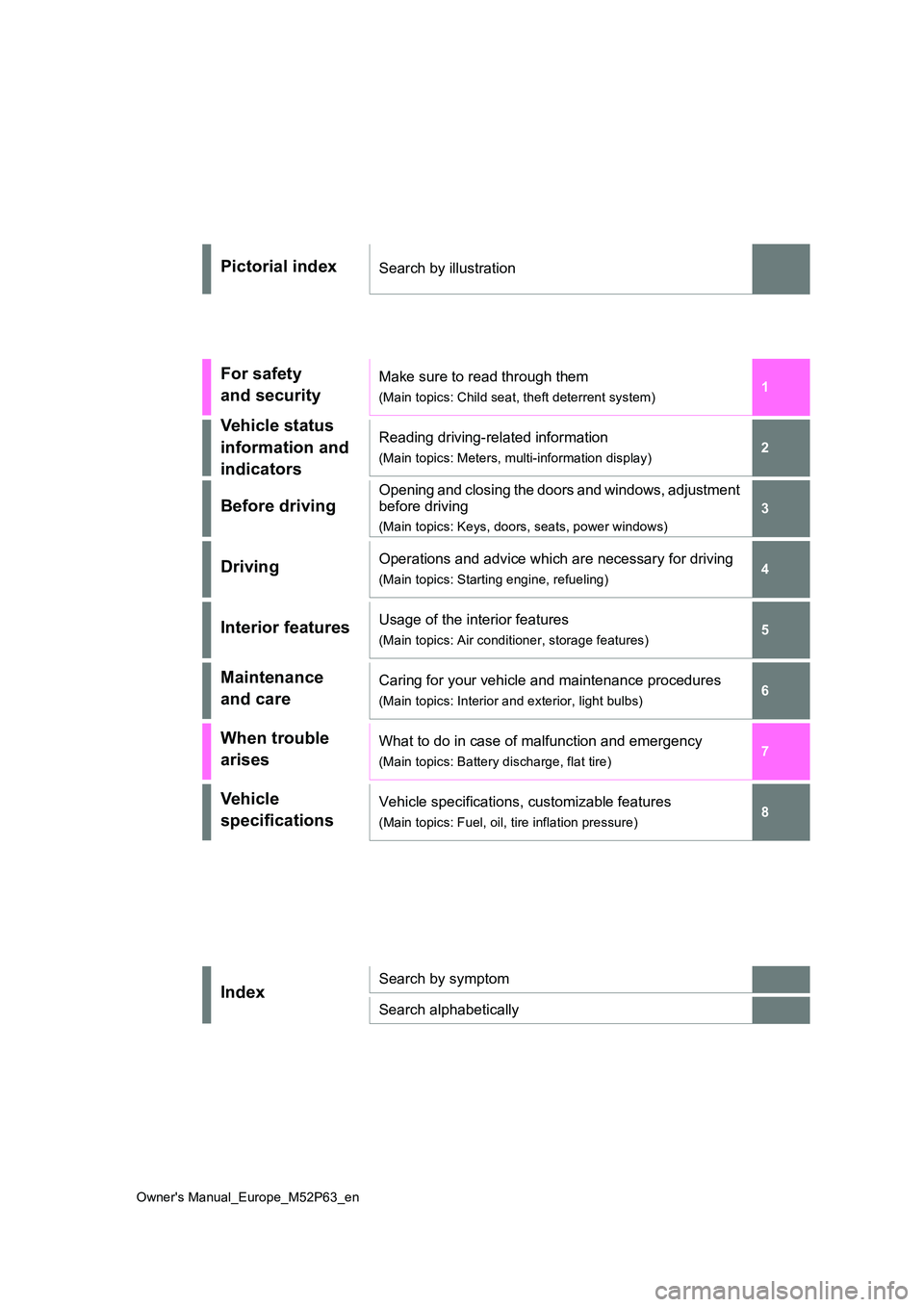
1
6
5
4
3
2
7
8
Owner's Manual_Europe_M52P63_en
Pictorial indexSearch by illustration
For safety
and security
Make sure to read through them
(Main topics: Child seat, theft deterrent system)
Vehicle status
information and
indicators
Reading driving-related information
(Main topics: Meters, multi-information display)
Before driving
Opening and closing the doors and windows, adjustment
before driving
(Main topics: Keys, doors, seats, power windows)
DrivingOperations and advice which are necessary for driving
(Main topics: Starting engine, refueling)
Interior featuresUsage of the interior features
(Main topics: Air conditioner, storage features)
Maintenance
and care
Caring for your vehicle and maintenance procedures
(Main topics: Interior and exterior, light bulbs)
When trouble
arises
What to do in case of malfunction and emergency
(Main topics: Battery discharge, flat tire)
Vehicle
specifications
Vehicle specifications, customizable features
(Main topics: Fuel, oil, tire inflation pressure)
IndexSearch by symptom
Search alphabetically
Page 6 of 470

4
Owner's Manual_Europe_M52P63_en
TABLE OF CONTENTS
6-4. Do-it-yourself maintenance
Do-it-yourself service precau-
tions .................................. 265
Hood ................................... 266
Positioning a floor jack ........ 268
Engine compartment........... 269
Battery ................................ 273
Tires .................................... 275
Replacing the tire ................ 285
Tire inflation pressure ......... 288
Wheels ................................ 290
Air conditioning filter ........... 291
Wireless remote control/elec-
tronic key battery .............. 293
Checking and replacing fuses
.......................................... 295
Light bulbs .......................... 299
7-1. Essential information
Emergency flashers ............ 304
If your vehicle has to be stopped
in an emergency ............... 304
If the vehicle is trapped in rising
water ................................. 305
7-2. Steps to take in an emergency
If your vehicle needs to be towed
.......................................... 307
If you think something is wrong
.......................................... 311
Fuel pump shut off system.. 312
If a warning light turns on or a
warning buzzer sounds..... 313
If a warning message is dis-
played ............................... 321
If you have a flat tire ........... 323
If the engine will not start .... 335
If you lose your keys ........... 336
If the electronic key does not
operate properly ............... 337
If the vehicle battery is dis-
charged............................. 339
If your vehicle overheats ..... 344
If the vehicle becomes stuck
.......................................... 346
8-1. Specifications
Maintenance data (fuel, oil level,
etc.)................................... 348
Fuel information .................. 357
8-2. Customization
Customizable features ........ 359
8-3. Initialization
Items to initialize ................. 367
8-4. Certifications
Certifications ....................... 368
7When trouble arises
8Vehicle specifications
Page 15 of 470
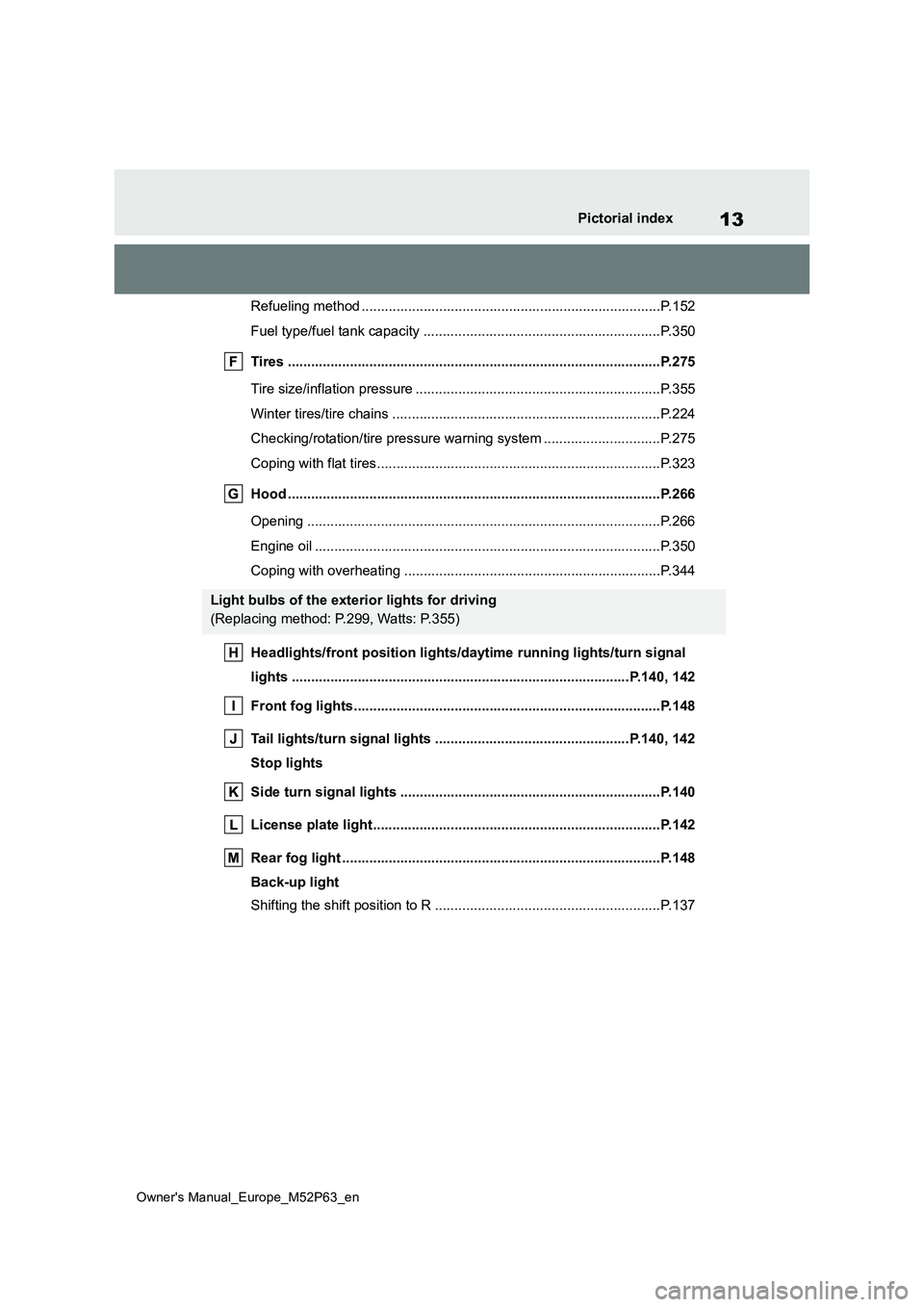
13
Owner's Manual_Europe_M52P63_en
Pictorial index
Refueling method .............................................................................P.152
Fuel type/fuel tank capacity ................................... ..........................P.350
Tires .......................................................... ......................................P.275
Tire size/inflation pressure ................................... ............................P.355
Winter tires/tire chains ....................................... ..............................P.224
Checking/rotation/tire pressure warning system ................. .............P.275
Coping with flat tires......................................... ................................P.323
Hood ........................................................... .....................................P.266
Opening ........................................................ ...................................P.266
Engine oil ..................................................... ....................................P.350
Coping with overheating ........................................ ..........................P.344
Headlights/front position lights/daytime running lights/turn si gnal
lights ......................................................... ..............................P.140, 142
Front fog lights............................................... ................................P.148
Tail lights/turn signal lights ................................. .................P.140, 142
Stop lights
Side turn signal lights ........................................ ...........................P.140
License plate light............................................ ..............................P.142
Rear fog light ................................................. .................................P.148
Back-up light
Shifting the shift position to R ............................... ...........................P.137
Light bulbs of the exterior lights for driving
(Replacing method: P.299, Watts: P.355)
Page 89 of 470
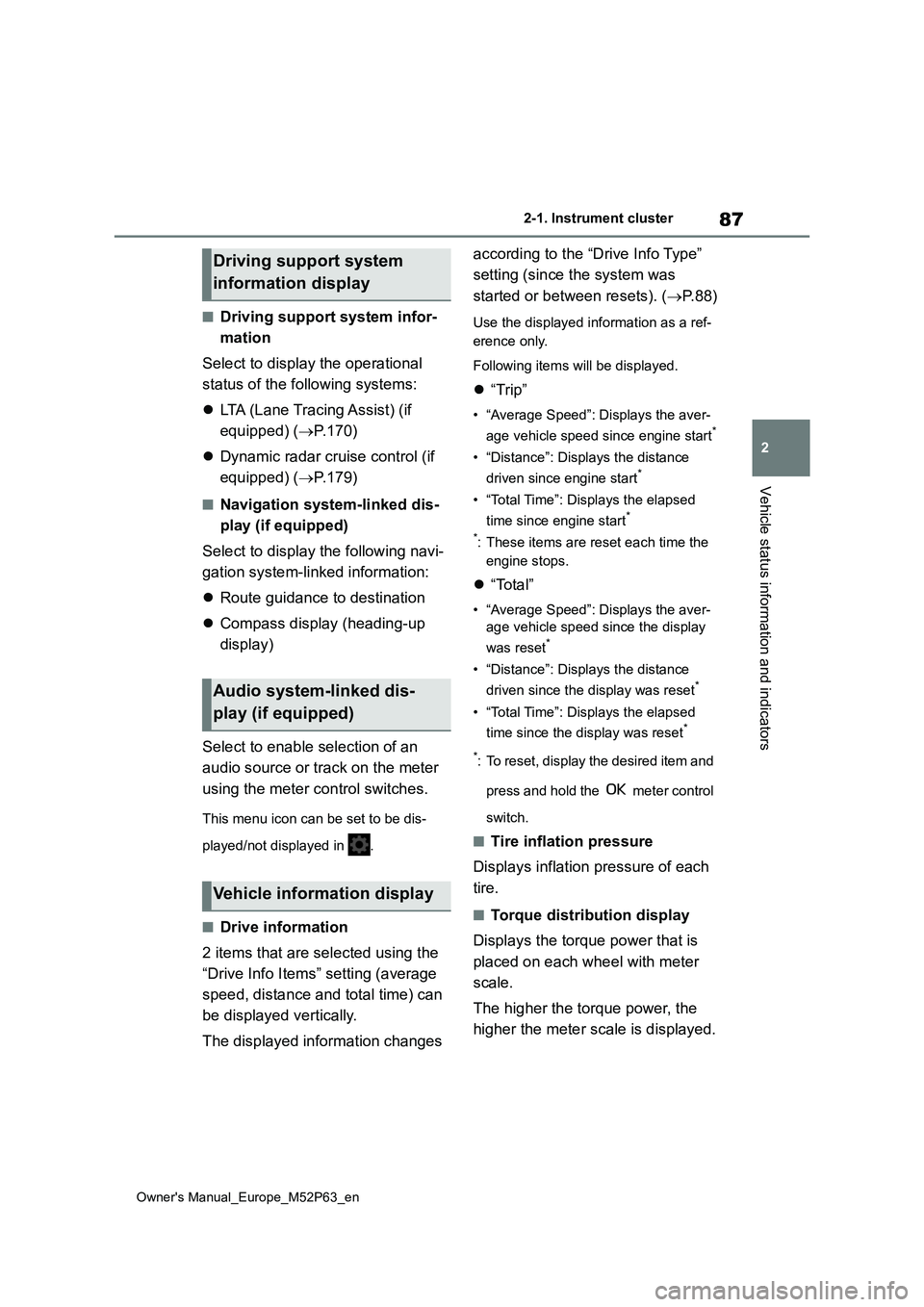
87
2
Owner's Manual_Europe_M52P63_en
2-1. Instrument cluster
Vehicle status information and indicators
■Driving support system infor-
mation
Select to display the operational
status of the following systems:
LTA (Lane Tracing Assist) (if
equipped) ( P.170)
Dynamic radar cruise control (if
equipped) ( P.179)
■Navigation system-linked dis-
play (if equipped)
Select to display the following navi-
gation system-linked information:
Route guidance to destination
Compass display (heading-up
display)
Select to enable selection of an
audio source or track on the meter
using the meter control switches.
This menu icon can be set to be dis-
played/not displayed in .
■Drive information
2 items that are selected using the
“Drive Info Items” setting (average
speed, distance and total time) can
be displayed vertically.
The displayed information changes
according to the “Drive Info Type”
setting (since the system was
started or between resets). ( P.88)
Use the displayed information as a ref-
erence only.
Following items will be displayed.
“Trip”
• “Average Speed”: Displays the aver-
age vehicle speed since engine start*
• “Distance”: Displays the distance
driven since engine start*
• “Total Time”: Displays the elapsed
time since engine start*
*: These items are reset each time the
engine stops.
“Total”
• “Average Speed”: Displays the aver-
age vehicle speed since the display
was reset*
• “Distance”: Displays the distance
driven since the display was reset*
• “Total Time”: Displays the elapsed
time since the display was reset*
*: To reset, display the desired item and
press and hold the meter control
switch.
■Tire inflation pressure
Displays inflation pressure of each
tire.
■Torque distribution display
Displays the torque power that is
placed on each wheel with meter
scale.
The higher the torque power, the
higher the meter scale is displayed.
Driving support system
information display
Audio system-linked dis-
play (if equipped)
Vehicle information display
Page 171 of 470
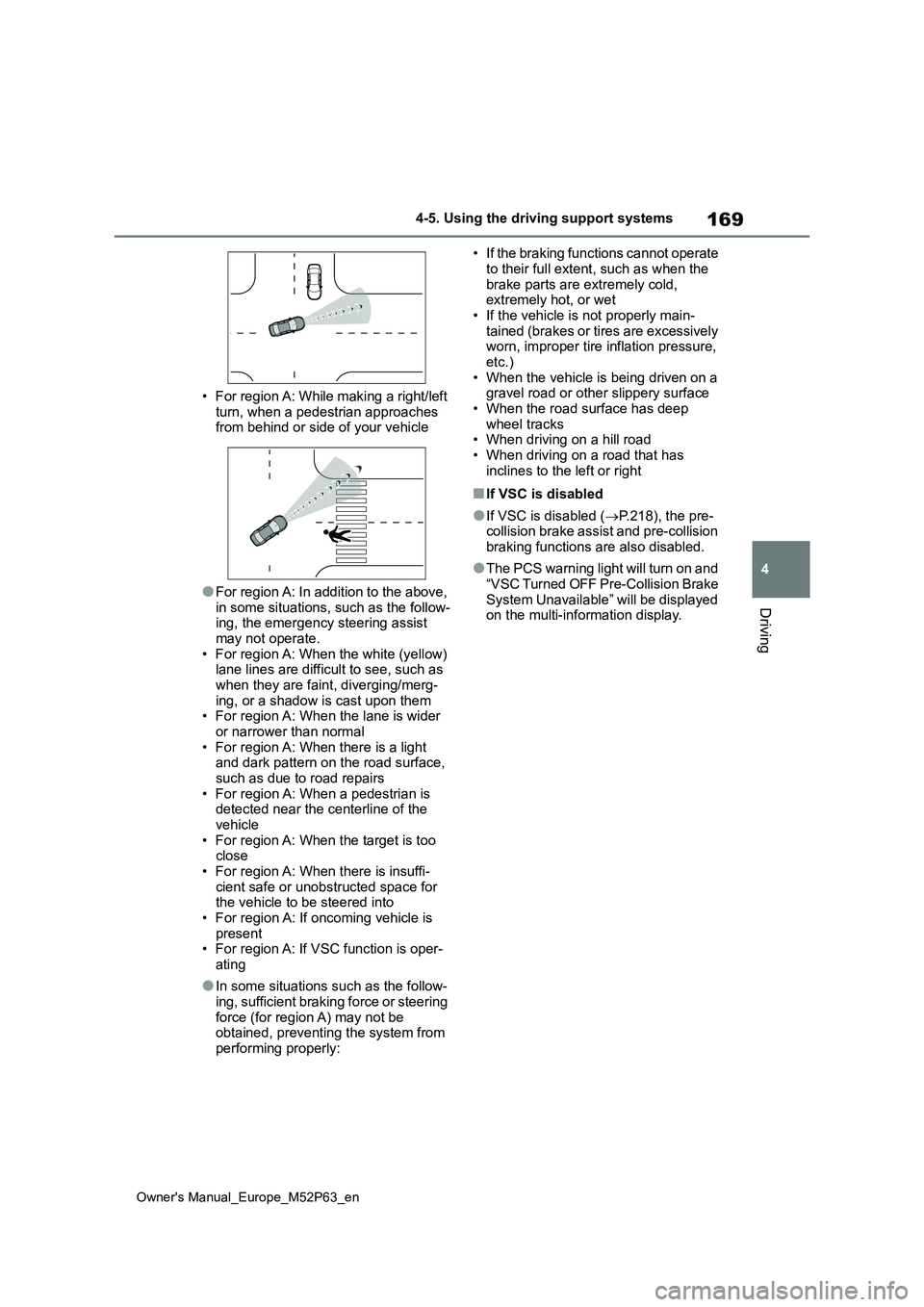
169
4
Owner's Manual_Europe_M52P63_en
4-5. Using the driving support systems
Driving
• For region A: While making a right/left
turn, when a pedestrian approaches from behind or side of your vehicle
●For region A: In addition to the above, in some situations, such as the follow-ing, the emergency steering assist
may not operate. • For region A: When the white (yellow) lane lines are difficult to see, such as
when they are faint, diverging/merg- ing, or a shadow is cast upon them• For region A: When the lane is wider
or narrower than normal • For region A: When there is a light and dark pattern on the road surface,
such as due to road repairs • For region A: When a pedestrian is detected near the centerline of the
vehicle • For region A: When the target is too close
• For region A: When there is insuffi- cient safe or unobstructed space for the vehicle to be steered into
• For region A: If oncoming vehicle is present• For region A: If VSC function is oper-
ating
●In some situations such as the follow-
ing, sufficient braking force or steering force (for region A) may not be obtained, preventing the system from
performing properly:
• If the braking functions cannot operate
to their full extent, such as when the brake parts are extremely cold, extremely hot, or wet
• If the vehicle is not properly main- tained (brakes or tires are excessively worn, improper tire inflation pressure,
etc.) • When the vehicle is being driven on a gravel road or other slippery surface
• When the road surface has deep wheel tracks• When driving on a hill road
• When driving on a road that has inclines to the left or right
■If VSC is disabled
●If VSC is disabled ( P.218), the pre- collision brake assist and pre-collision braking functions are also disabled.
●The PCS warning light will turn on and “VSC Turned OFF Pre-Collision Brake
System Unavailable” will be displayed on the multi-information display.
Page 247 of 470

6
245
Owner's Manual_Europe_M52P63_en
6
Maintenance and care
Maintenance and care
6-1. Maintenance and care
Cleaning and protecting the
vehicle exterior ............... 246
Cleaning and protecting the
vehicle interior ................ 249
6-2. Matte paint care guide (if
equipped)
Basic knowledge about matte
clear coat ........................ 252
Washing your vehicle........ 256
Frequently Asked Questions
....................................... 259
6-3. Maintenance
Maintenance requirements 263
6-4. Do-it-yourself maintenance
Do-it-yourself service precau-
tions ................................ 265
Hood ................................. 266
Positioning a floor jack...... 268
Engine compartment ........ 269
Battery .............................. 273
Tires .................................. 275
Replacing the tire.............. 285
Tire inflation pressure ....... 288
Wheels.............................. 290
Air conditioning filter ......... 291
Wireless remote control/elec-
tronic key battery ............ 293
Checking and replacing fuses
....................................... 295
Light bulbs ........................ 299
Page 267 of 470
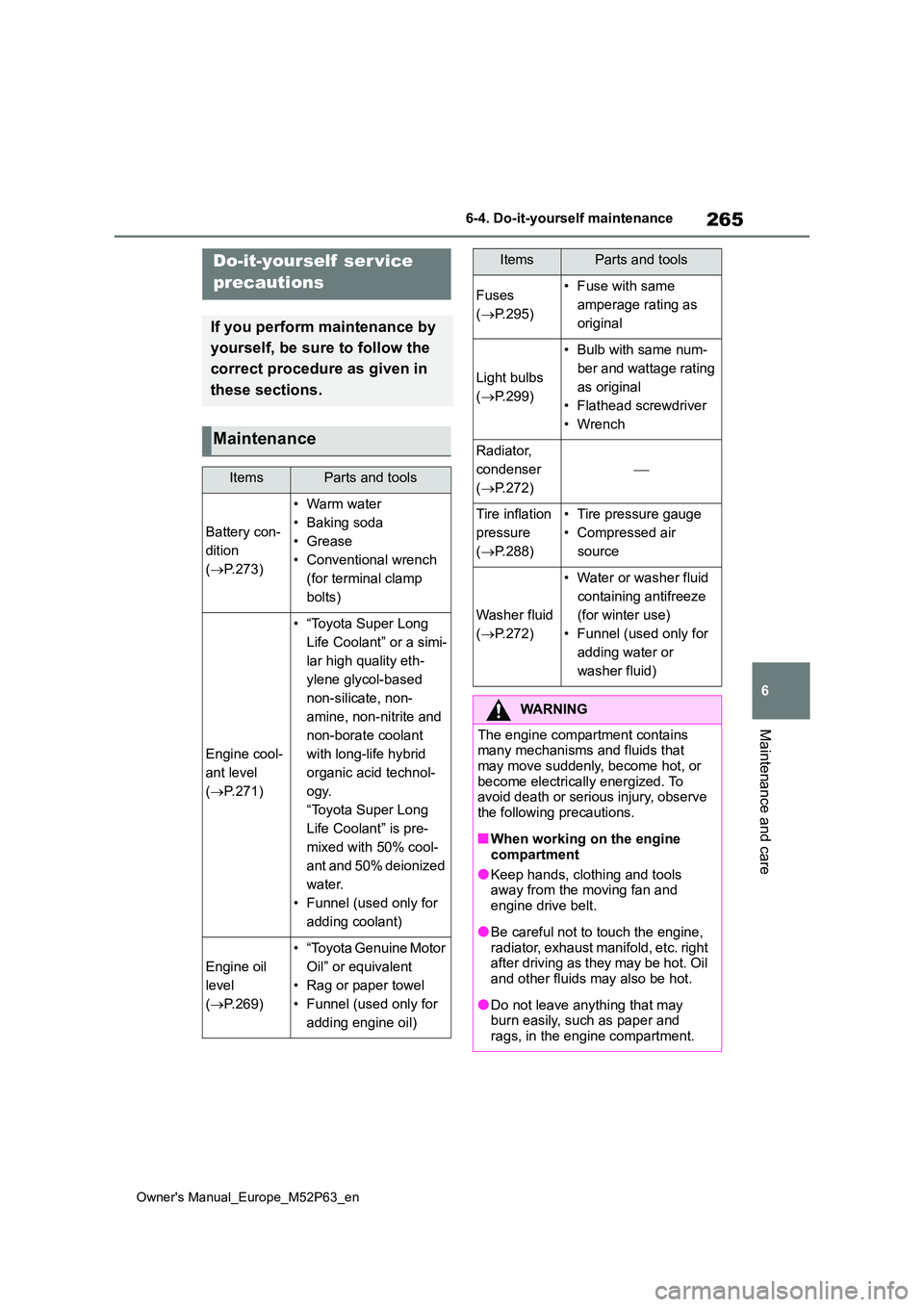
265
6
Owner's Manual_Europe_M52P63_en
6-4. Do-it-yourself maintenance
Maintenance and care
6-4.Do-it-y ours elf main ten ance
Do-it-yourself ser vice
precautions
If you perform maintenance by
yourself, be sure to follow the
correct procedure as given in
these sections.
Maintenance
ItemsParts and tools
Battery con-
dition
( P.273)
•Warm water
• Baking soda
• Grease
• Conventional wrench
(for terminal clamp
bolts)
Engine cool-
ant level
( P.271)
• “Toyota Super Long
Life Coolant” or a simi-
lar high quality eth-
ylene glycol-based
non-silicate, non-
amine, non-nitrite and
non-borate coolant
with long-life hybrid
organic acid technol-
ogy.
“Toyota Super Long
Life Coolant” is pre-
mixed with 50% cool-
ant and 50% deionized
water.
• Funnel (used only for
adding coolant)
Engine oil
level
( P.269)
• “Toyota Genuine Motor
Oil” or equivalent
• Rag or paper towel
• Funnel (used only for
adding engine oil)
Fuses
( P.295)
• Fuse with same
amperage rating as
original
Light bulbs
( P.299)
• Bulb with same num-
ber and wattage rating
as original
• Flathead screwdriver
•Wrench
Radiator,
condenser
( P.272)
Tire inflation
pressure
( P.288)
• Tire pressure gauge
• Compressed air
source
Washer fluid
( P.272)
• Water or washer fluid
containing antifreeze
(for winter use)
• Funnel (used only for
adding water or
washer fluid)
WARNING
The engine compartment contains many mechanisms and fluids that
may move suddenly, become hot, or become electrically energized. To avoid death or serious injury, observe
the following precautions.
■When working on the engine
compartment
●Keep hands, clothing and tools away from the moving fan and
engine drive belt.
●Be careful not to touch the engine,
radiator, exhaust manifold, etc. right after driving as they may be hot. Oil and other fluids may also be hot.
●Do not leave anything that may burn easily, such as paper and
rags, in the engine compartment.
ItemsParts and tools
Page 278 of 470
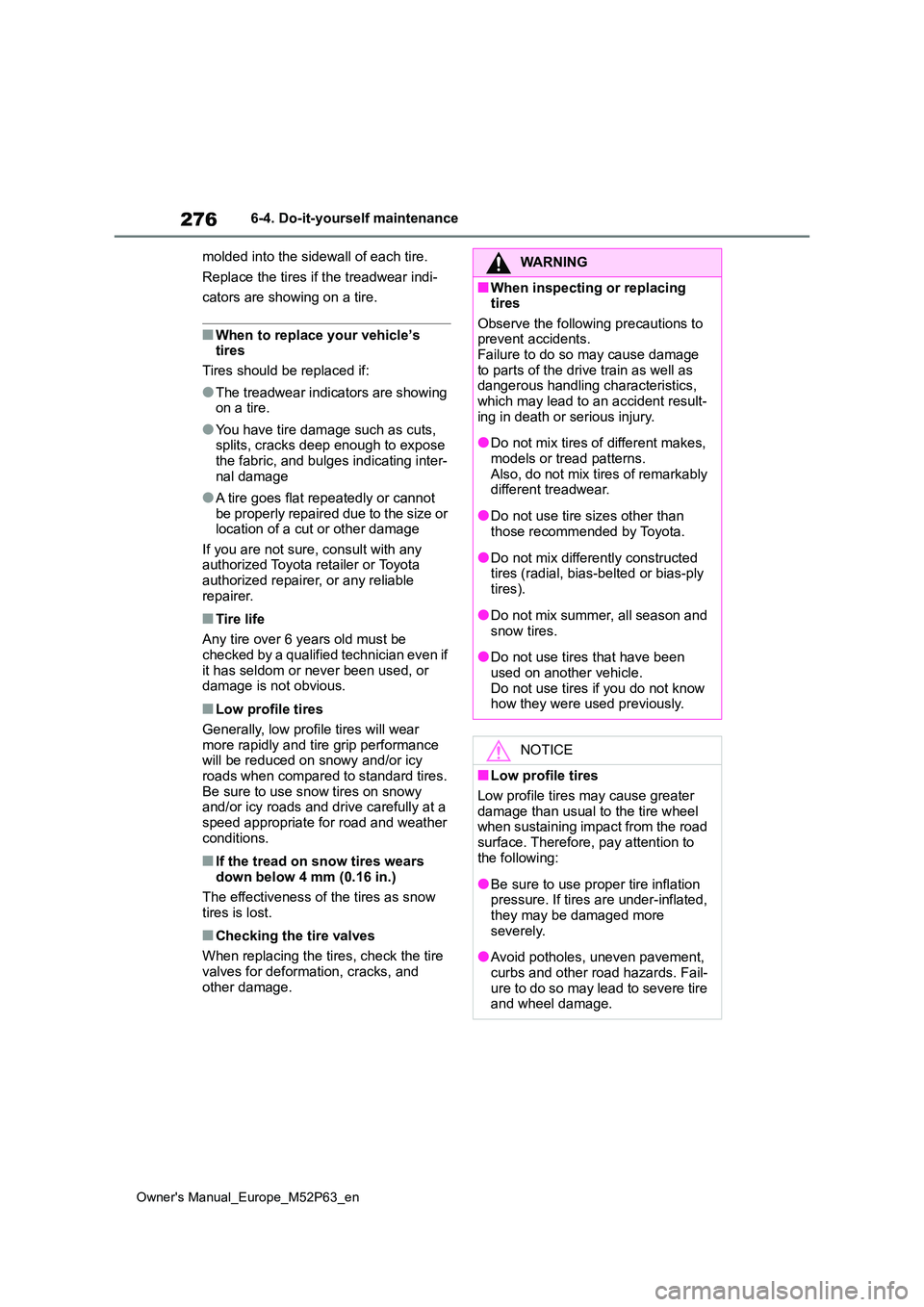
276
Owner's Manual_Europe_M52P63_en
6-4. Do-it-yourself maintenance
molded into the sidewall of each tire.
Replace the tires if the treadwear indi-
cators are showing on a tire.
■When to replace your vehicle’s tires
Tires should be replaced if:
●The treadwear indicators are showing on a tire.
●You have tire damage such as cuts, splits, cracks deep enough to expose
the fabric, and bulges indicating inter- nal damage
●A tire goes flat repeatedly or cannot be properly repaired due to the size or location of a cut or other damage
If you are not sure, consult with any authorized Toyota retailer or Toyota authorized repairer, or any reliable
repairer.
■Tire life
Any tire over 6 years old must be checked by a qualified technician even if
it has seldom or never been used, or damage is not obvious.
■Low profile tires
Generally, low profile tires will wear
more rapidly and tire grip performance will be reduced on snowy and/or icy roads when compared to standard tires.
Be sure to use snow tires on snowy and/or icy roads and drive carefully at a speed appropriate for road and weather
conditions.
■If the tread on snow tires wears down below 4 mm (0.16 in.)
The effectiveness of the tires as snow
tires is lost.
■Checking the tire valves
When replacing the tires, check the tire
valves for deformation, cracks, and other damage.
WARNING
■When inspecting or replacing tires
Observe the following precautions to prevent accidents.Failure to do so may cause damage
to parts of the drive train as well as dangerous handling characteristics, which may lead to an accident result-
ing in death or serious injury.
●Do not mix tires of different makes,
models or tread patterns. Also, do not mix tires of remarkably different treadwear.
●Do not use tire sizes other than those recommended by Toyota.
●Do not mix differently constructed tires (radial, bias-belted or bias-ply
tires).
●Do not mix summer, all season and
snow tires.
●Do not use tires that have been
used on another vehicle. Do not use tires if you do not know how they were used previously.
NOTICE
■Low profile tires
Low profile tires may cause greater damage than usual to the tire wheel when sustaining impact from the road
surface. Therefore, pay attention to the following:
●Be sure to use proper tire inflation pressure. If tires are under-inflated, they may be damaged more
severely.
●Avoid potholes, uneven pavement,
curbs and other road hazards. Fail- ure to do so may lead to severe tire and wheel damage.
Page 279 of 470
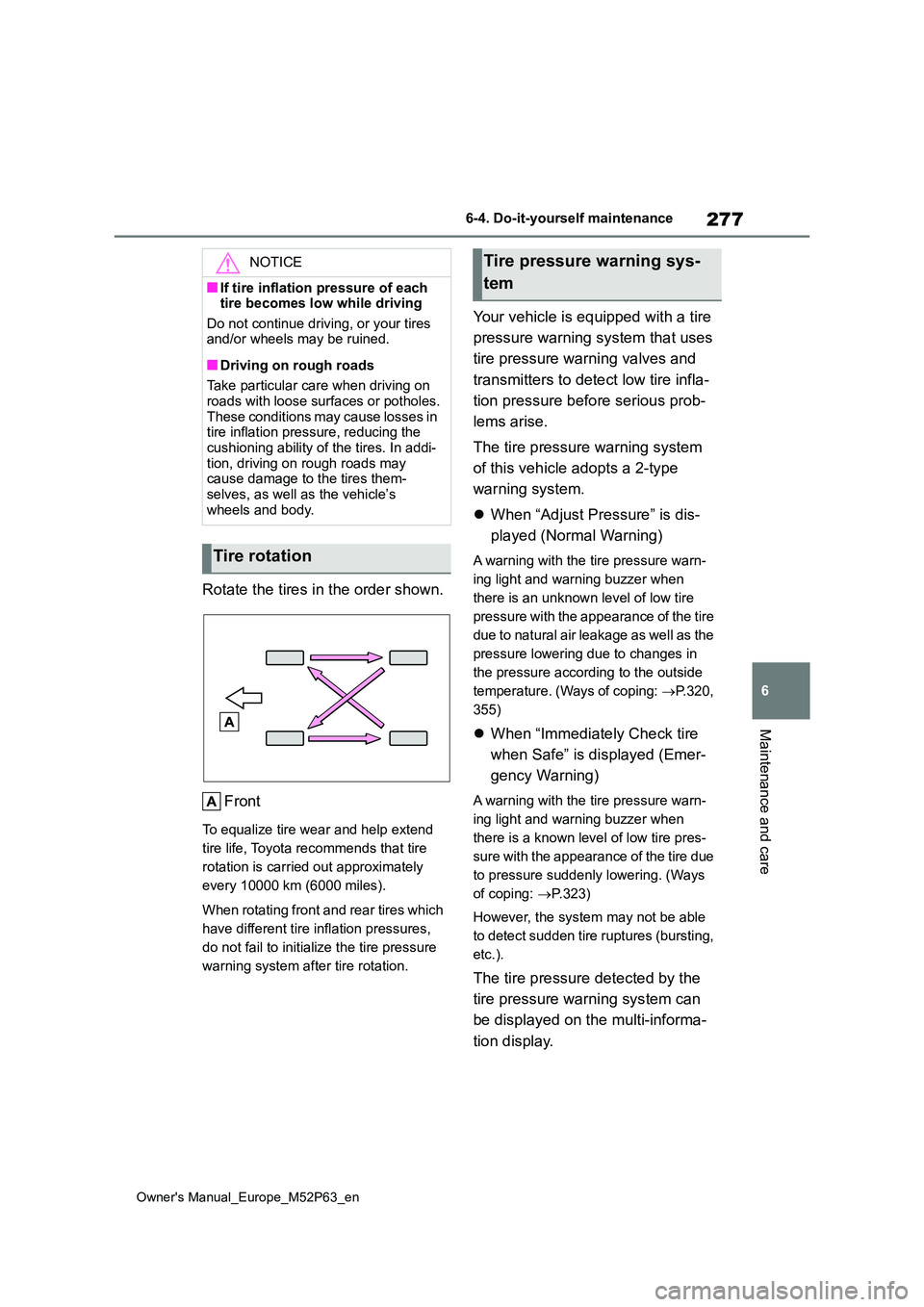
277
6
Owner's Manual_Europe_M52P63_en
6-4. Do-it-yourself maintenance
Maintenance and care
Rotate the tires in the order shown.
Front
To equalize tire wear and help extend
tire life, Toyota recommends that tire
rotation is carried out approximately
every 10000 km (6000 miles).
When rotating front and rear tires which
have different tire inflation pressures,
do not fail to initialize the tire pressure
warning system after tire rotation.
Your vehicle is equipped with a tire
pressure warning system that uses
tire pressure warning valves and
transmitters to detect low tire infla-
tion pressure before serious prob-
lems arise.
The tire pressure warning system
of this vehicle adopts a 2-type
warning system.
When “Adjust Pressure” is dis-
played (Normal Warning)
A warning with the tire pressure warn-
ing light and warning buzzer when
there is an unknown level of low tire
pressure with the appearance of the tire
due to natural air leakage as well as the
pressure lowering due to changes in
the pressure according to the outside
temperature. (Ways of coping: P.320,
355)
When “Immediately Check tire
when Safe” is displayed (Emer-
gency Warning)
A warning with the tire pressure warn-
ing light and warning buzzer when
there is a known level of low tire pres-
sure with the appearance of the tire due
to pressure suddenly lowering. (Ways
of coping: P.323)
However, the system may not be able
to detect sudden tire ruptures (bursting,
etc.).
The tire pressure detected by the
tire pressure warning system can
be displayed on the multi-informa-
tion display.
NOTICE
■If tire inflation pressure of each tire becomes low while driving
Do not continue driving, or your tires and/or wheels may be ruined.
■Driving on rough roads
Take particular care when driving on roads with loose surfaces or potholes.
These conditions may cause losses in tire inflation pressure, reducing the cushioning ability of the tires. In addi-
tion, driving on rough roads may cause damage to the tires them-selves, as well as the vehicle’s
wheels and body.
Tire rotation
Tire pressure warning sys-
tem
Page 280 of 470
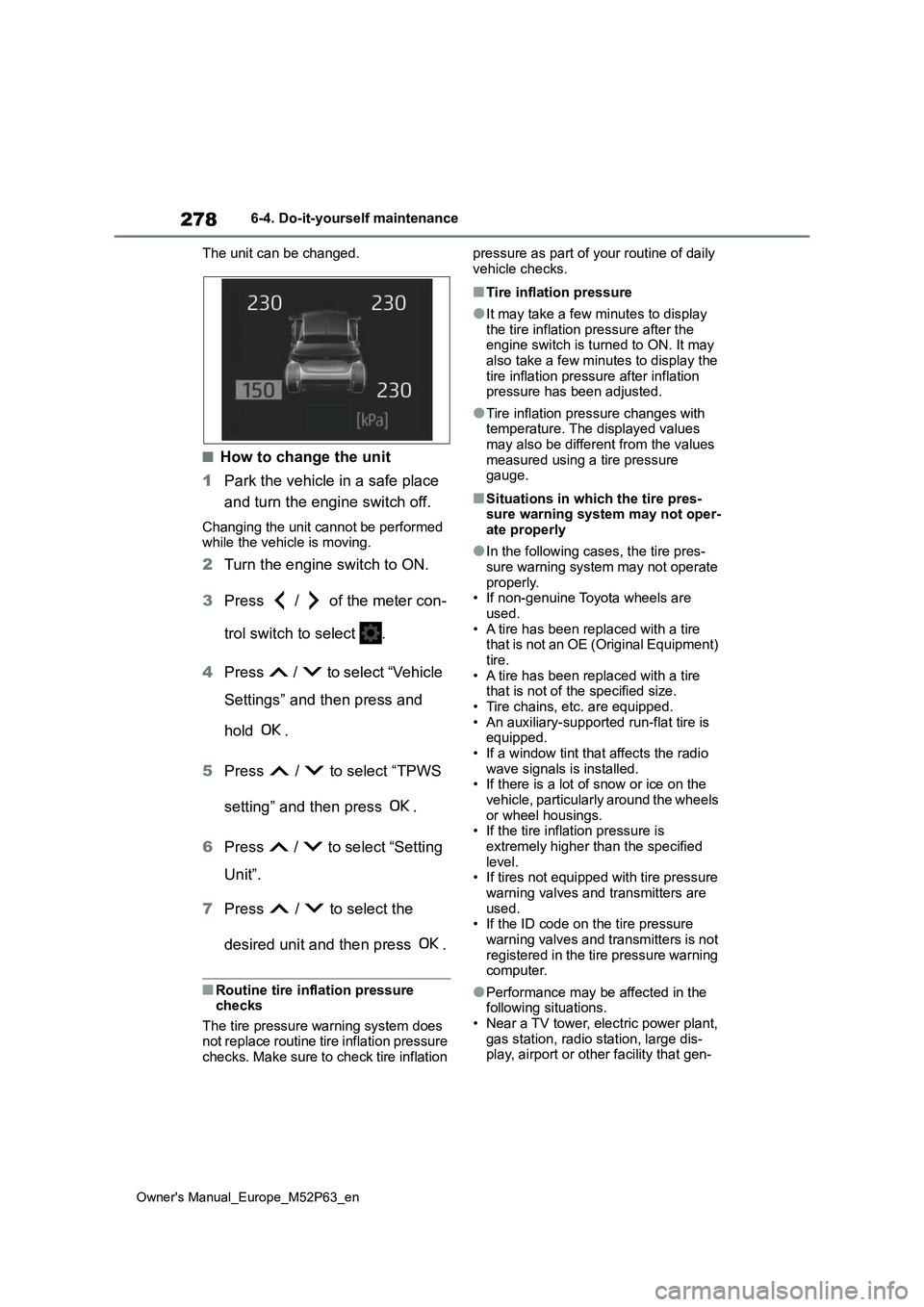
278
Owner's Manual_Europe_M52P63_en
6-4. Do-it-yourself maintenance
The unit can be changed.
■How to change the unit
1 Park the vehicle in a safe place
and turn the engine switch off.
Changing the unit cannot be performed while the vehicle is moving.
2 Turn the engine switch to ON.
3 Press / of the meter con-
trol switch to select .
4 Press / to select “Vehicle
Settings” and then press and
hold .
5 Press / to select “TPWS
setting” and then press .
6 Press / to select “Setting
Unit”.
7 Press / to select the
desired unit and then press .
■Routine tire inflation pressure checks
The tire pressure warning system does not replace routine tire inflation pressure checks. Make sure to check tire inflation
pressure as part of your routine of daily
vehicle checks.
■Tire inflation pressure
●It may take a few minutes to display
the tire inflation pressure after the engine switch is turned to ON. It may also take a few minutes to display the
tire inflation pressure after inflation pressure has been adjusted.
●Tire inflation pressure changes with temperature. The displayed values may also be different from the values
measured using a tire pressure gauge.
■Situations in which the tire pres-sure warning system may not oper-
ate properly
●In the following cases, the tire pres-
sure warning system may not operate properly.• If non-genuine Toyota wheels are
used. • A tire has been replaced with a tire that is not an OE (Original Equipment)
tire. • A tire has been replaced with a tire that is not of the specified size.
• Tire chains, etc. are equipped. • An auxiliary-supported run-flat tire is equipped.
• If a window tint that affects the radio wave signals is installed.• If there is a lot of snow or ice on the
vehicle, particularly around the wheels or wheel housings.• If the tire inflation pressure is
extremely higher than the specified level.• If tires not equipped with tire pressure
warning valves and transmitters are used.• If the ID code on the tire pressure
warning valves and transmitters is not registered in the tire pressure warning computer.
●Performance may be affected in the following situations.
• Near a TV tower, electric power plant, gas station, radio station, large dis-play, airport or other facility that gen-